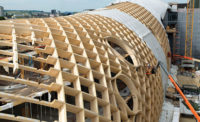Designing a house can be difficult. But designing your own can be especially challenging. This was the case for Jason McLennan and Heron Hall, the house on Bainbridge Island, Washington, which he designed for himself and his wife, Tracy, and their children. It was natural that McLennan would set a high bar for the 3,300-square-foot structure completed in April: although he is the founder of an eponymous design firm, he is best known as the author of the Living Building Challenge (LBC). That green building-certification system is widely regarded as the world’s most stringent and has a host of tough-to-satisfy requirements, including submission of 12 months of post-occupancy data to demonstrate net zero operations for energy and water. Only 15 projects have achieved full Living Building status since the program’s launch in 2007.
Of course, McLennan plans to submit the house for certification once all the data are available. But at Heron Hall, named after the bird regularly spotted on the one-acre site, McLennan’s ambitions are already visible, starting with the 10kW photovoltaic (PV) array on the south-facing slope of the long gabled roof. This defines the house’s barnlike volume and shelters a double-story living/dining space and an adjacent master suite on the first floor, as well as the children’s bedrooms and a family room above.
Additional Content:
Jump to credits & specifications
In addition to the PVs, which are expected to generate at least as much electricity as the house consumes over the course of a year, other resource-conserving strategies include a heavily insulated, airtight building envelope and a radiant system for space heating and hot water. Because the house is not connected to the municipal water or sewer system (a feature that entailed modifying the local building code), it has composting toilets and a 15,000-gallon rainwater cistern for all water needs, even drinking.
McLennan chose uber-sustainable materials: above a rammed-earth base, the house is made almost entirely of wood, inside and out. It has Douglas fir roof trusses, interior paneling made from cottonwood trees cleared from the site, charred cedar exterior siding, reclaimed flooring, and a few well-placed muscular beams from dismantled old heavy timber structures. It is a “carbon sequestering house,” says McLennan, referring to wood’s carbon dioxide–retaining properties. Although Heron Hall is an assemblage of several volumes, the house’s primary element is a barnlike enclosure. Its gabled roof shelters the main living spaces, including a double-story living and dining area.
The house incorporates repurposed items, such as stained-glass windows from a local church built in the 1920s, wicker beehives transformed into light fixtures, and a set of hand-carved doors from Afghanistan that had been brought to Seattle a decade ago and then discarded. McLennan calls this aesthetic “Salvage Modernism.” If it is done right, he says, “the old and new make each other better.”
It is also a showcase for commercially available materials and finishes that McLennan developed in collaboration with manufacturers, including carpet tiles with a pattern inspired by lichen; the rammed-earth system, which incorporates reinforcement and insulation; and pavers made from remnant stone. These products, as well as all the others used in the house, are free of the 22 potentially toxic substances prohibited in LBC projects but commonplace in building materials.
Visitors to Heron Hall may not even be aware of the absence of the noxious cocktail of chemical odors often present in new buildings. But they are sure to take note of its mix of materials and textures, its light and airy look, and the quirky remnants from old buildings. And that’s just what McLennan had in mind. He hopes guests will leave saying, “If this is a Living Building, then I want one.”
CreditsArchitect: [McLennan Design, 175 Parfitt Way SW, Suite N160, Bainbridge Island, WA 98110, 206-219-3777, mclennan-design.com]
Personnel in architect's firm who should receive special credit: [Jason F. McLennan, Joshua Fisher, Dale Duncan, Julia Drachman, Mona Lemoine, Louise Hamot, Steven Christian]
Architect of record: [McLennan Design, 175 Parfitt Way SW, Suite N160, Bainbridge Island, WA 98110, 206-219-3777, mclennan-design.com]
Interior designer: McLennan Design
Engineers MEP Engineer – Integral Group Structural Engineer – Associated Engineering
Consultants Steven Strong – Solar Design Associates – Solar Hans Frederickson – Frederickson Electric – Solar Rick Blumenthal – Knauf Insulation – Building Enclosure Glenn Nelson – Advanced Composting Systems – Phoenix Composting Toilet Ken Blair – RainBank – Rainwater Systems Joss Krayenhoff – Sirewall – Structural Insulated Rammed Earth
General contractor: Smallwood Design and Construction
Photographer: Daniel Banko |
Specifications
Structural System Sirewall Rammed Earth Wall System
Exterior Cladding Wood: Cedar FSC Wood from Sustainable Northwest Woods Moisture barrier: Prosoco Air Barrier – R Guard Other cladding unique to this project: Burnt Wood Siding of FSC Cedar
Roofing Metal: Metal Sales new Valspar Coating Other: Green Roof by Columbia Green Technologies
Windows Wood frame: Jeld-Wen Salvaged Wood windows
Doors Wood doors: Jeld-Wen Special doors: Antique Salvaged Doors from Earthwise Salvage
Hardware Closers: Assa Abloy Pulls: Assa Abloy Other special hardware: Assa Abloy – barn door hardware and closers
Interior Finishes Cabinetwork and custom woodwork: Neil Kelly Cabinets Paints and stains: ECOS Paints Paneling: FSC and Salvaged wood interior paneling Floor and wall tile: Cold Spring Earth Measure Carpet: Mohawk, Lichen Collection Special interior finishes unique to this project: Coyote Woodworks Urban Salvage Stair treads and interior wood tile. Concrete Counters: Ryan McPhail
Lighting Downlights: David Trubridge Lighting; Brandan Perhacs, Perhacs Studio; Kelly Asadorian, Myorian Studio
Plumbing Shower: Nevia Atomizing Shower Other water products: Kohler Bathtub: Salvaged Claw foot tub Cistern: RainBank Cistern Toilet: Phoenix Composting Toilets
Energy Photovoltaic system: SolarWorld, Solar Design Associates Super Efficient Envelope Passive Solar Design No Air Conditioning – 100% naturally cooled in summer Solar also powers family’s electric cars.
Extensive Use of Salvaged Materials Throughout Onsite Timber Harvesting, milling and use Urban Salvage Lumber ALL FSC wood for all wood products other than salvaged or on-site.
Sirewall Rammed Earth Walls
Big Ass Fan in Main Space |









